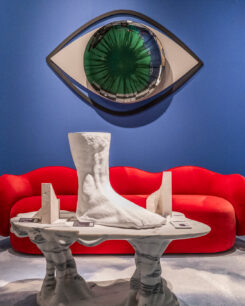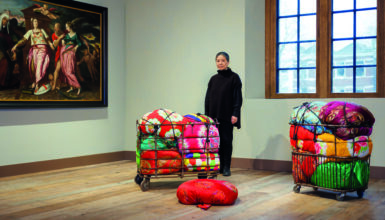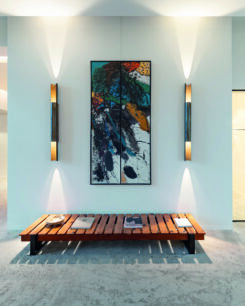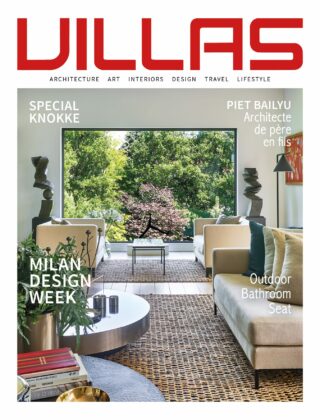Sommaire
The life of an artist who exalted ceramics and design
One of the most important Belgian artists
Pierre Culot lived and worked in Roux-Miroir, a small town in Walloon Brabant, until his death. The Belgian artist completed his education at the Atelier de céramique de Maredsous, then at the École nationale supérieure d’Architecture et des Arts décoratifs de la Cambre (ENSAAD) in Brussels.
Born in 1938 and deceased in 2011, he continuously moved back and forth between art and utilitarian objects throughout his career. Art reproduces the two aspects which were close to the famous ceramist’s heart. He was not only a visual artist, but also a landscape artist, designer and even a collector. Robert Deblander, Elisabeth Joulia, Antoine de Vinck and Piet Stockmans, among others, are part of his large collection. Exhibited during his lifetime at the Royal Museums of Art and History in Brussels, other institutions outside Belgium such as the Victoria and Albert Museum in London and the Stedelijk Museum in Amsterdam devoted major monographic exhibitions to him during the mid-1970s and 1990s.
During the sixties, Pierre Culot escaped from Belgium for a while to devote himself fully to his success. He was introduced to the Parisians by Galerie Primavera, purveyor of Lucie Rie’s delicate creations. He also travelled extensively. In Italy, he visited Giorgio Morandi and fell in love with his still life art. In Japan, he met the ceramist Shoji Hamada of the Mingei movement. In India he discovered Chandigarh. A place famous for having inspired the designs of Le Corbusier and Pierre Jeanneret, published by the Italian brand Cassina.
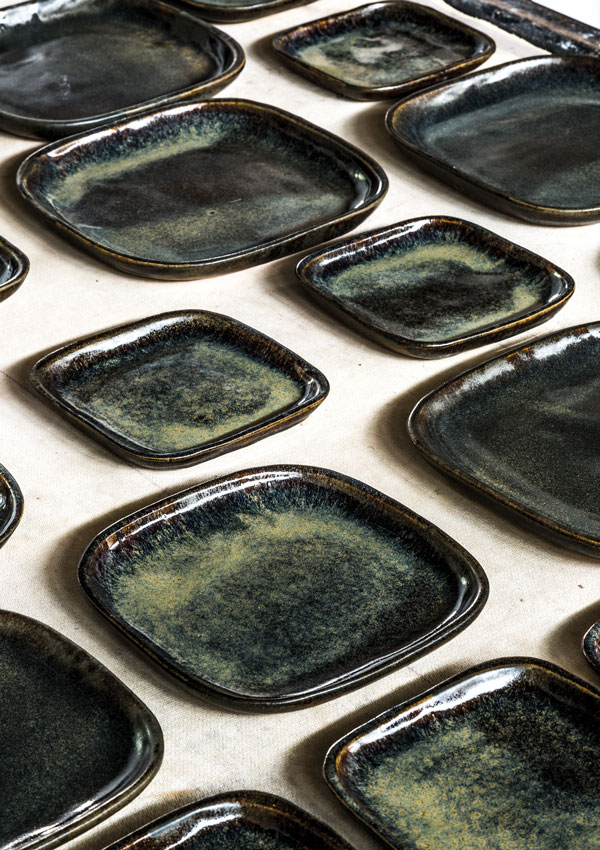
Michel Figuet
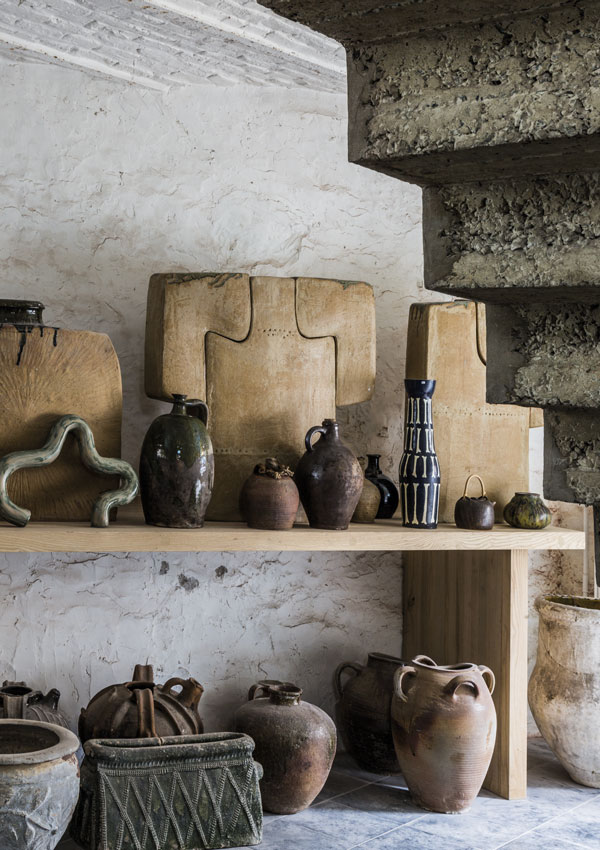
Michel Figuet
His private estate: a unique place full of history
Pierre Culot’s house, and especially the part of it that can be seen from the outside, is a place of memory and also of archiving, and presents the most sculptural sum of the artist’s work. The inclusion of his monumental ceramic and brick creations in the garden was very important to him. He wanted nature to take over, for the ivy to climb up his sculptures or for them to merge freely with the poplar trees. The paving stone floors were designed by the artist and his personal collections and sculptures fill the garden. Everything here breathes the four elements: earth, wood, fire, metal. Powerful art.
Inside this magical home, which blends bucolic ambience, Amish style and architectural minimalism, the past and the present come together beautifully. Here, Pierre Culot designed unique furniture and table lamps – some inspired by those of the self-taught designer and architect Jules Wabbes. The other interior design elements are inspired by the geometric paintings of the artist Victor Vasarely. Pierre Culot designed them from the mid-1960s to the 1980s. Today, the republication of his models aims to respect the DNA of his style and his techniques.
Timeless creations and contemporary collaborations
A house of art revisited by new heirs
From now on, Pierre Culot’s house, his garden and his workshop form the Atelier Pierre Culot. Joseph Culot has been giving his father Pierre Culot’s home and creations a new lease of life since 2016. He became the guarantor of the memory of one of the greatest Belgian potters, supported by two friends and partners: Arnaud Van Schevensteen, the man behind the project, and Dimitri Jeurissen, founder and creative director of the art direction agency Base Design, which advises institutions such as MoMA in New York and companies such as the coworking space company Silversquare.
Sorting Pierre Culot’s archives and publications as well as his exhibition catalogues was their very first task. Since then, they have extended invitations to artists and even brands such as the Maison Dandoy biscuit factory to be inspired by his art and to propose new exhibitions and products. The artists’ residency at the Atelier Pierre Culot invites two artists per year to compare their practices with the work of Pierre Culot. The first residency was awarded to the Belgian plastic artist Eric Croes. The second residency was given to the Franco-British sculptors Daniel Dewar and Grégory Gicquel, a duo that won the Marcel Duchamp Prize, a major award.
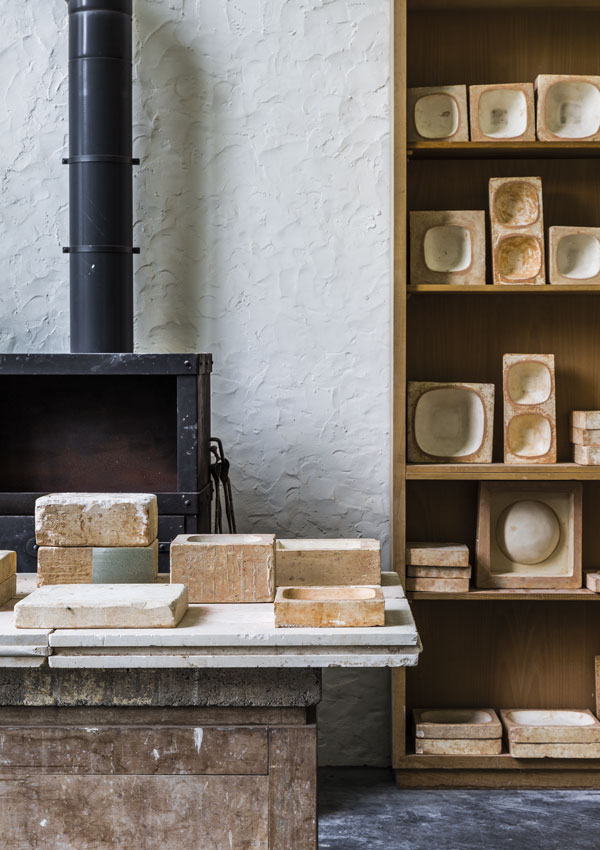
Michel Figuet
The new life of the ceramics and design of Pierre Culot
A true constant in Pierre Culot’s work, the art of the table (a type of object that represented for him the ancient symbol of human dignity), is today produced by his new heirs from the original moulds of his workshop. More lively and animated than ever, his house and workshop is now experiencing new momentum thanks to the relaunch of the house furnace which allows for the reproduction of iconic pieces, all made in Belgium:
- Pierre Culot’s tableware; functional objects (square plates, teapots) that go against industrial design. They are devoid of superfluous materials and are still made by hand, evidenced by the traces of turning on the surface;
- furniture; dining room tables and coffee tables by the artist designer. These are the result of exceptional work with natural stone: blue-grey limestone from Hainaut and Burgundy stone with its warm beige tone;
- partitions or screens, room dividers for the creation or layout of walls in the home in order to modulate spaces and light. Those signed Atelier Pierre Culot are based on the artist’s original drawings and their design in ceramic and are offered for sale to individuals and public places;
- lights: brass, bronze and terracotta characterise the originality of Pierre Culot’s lamp bases. Their first foundations date back to 1965.
Some of the most recent recreations are sold in selective outlets such as the shop and showroom of the Belgian designer Marina Bautier in Brussels.
Between an ancestral pottery tradition and singular creativity which is recognisable at first sight, the art of Belgian Pierre Culot reaches across fashion: it is the very essence of the word “timeless”.
Visit the Atelier Pierre Culot by appointment,
Rue de la Poterie 7, 1315 Roux-Miroir
info@pierreculot.com
atelierpierreculot.com

